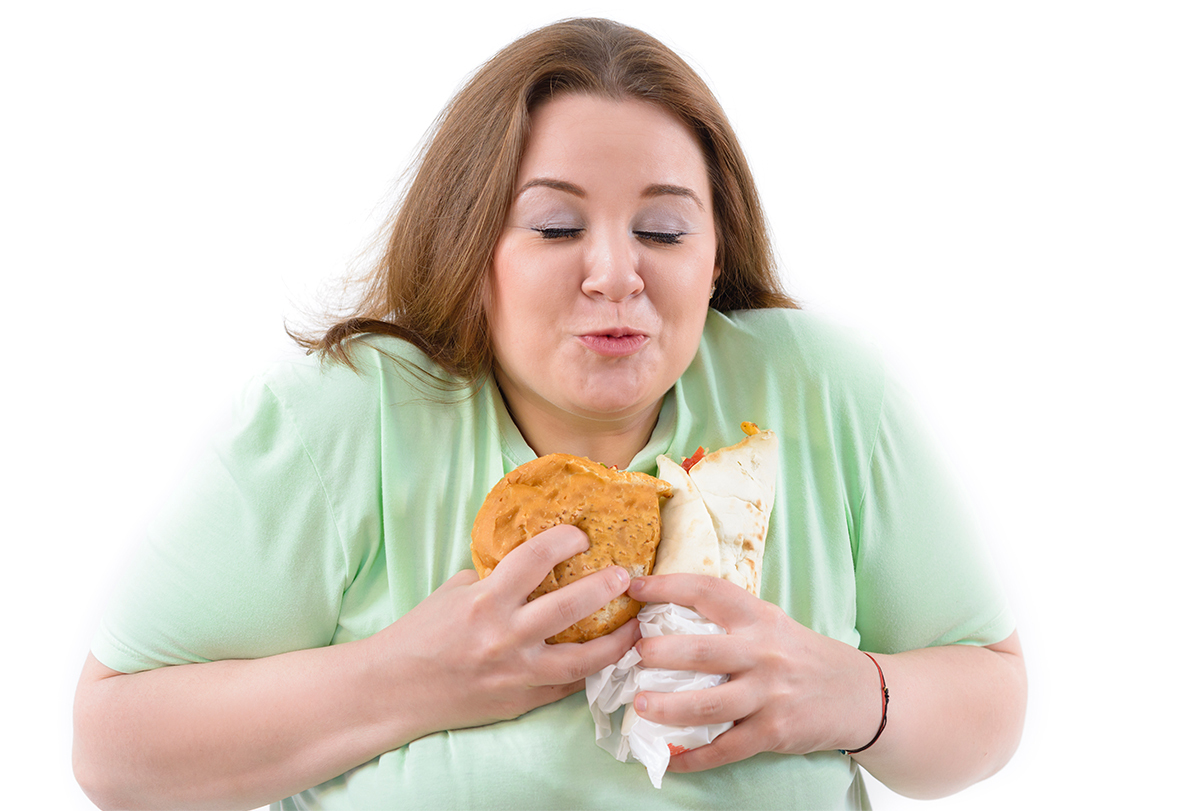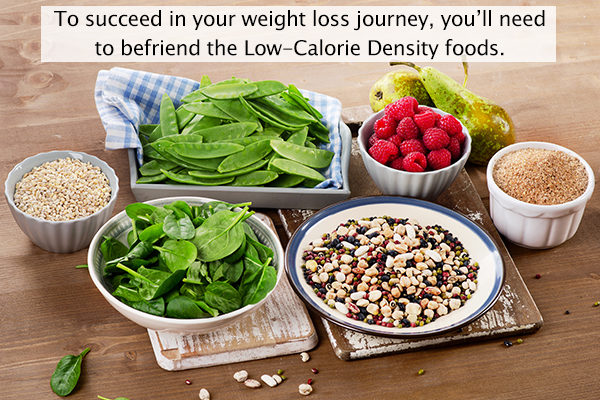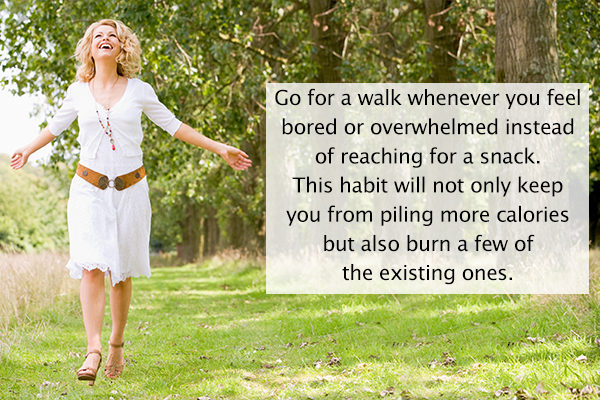In this article:
Most people who have tried losing and maintaining weight are probably familiar with this old annoying “prescription”: just eat less and move more!

From the point of energy balance, this is a true statement. However, in real life, the body’s unique physiology and genetic and metabolic makeup play a significant role in regulating appetite and weight.
While some factors, such as genes and certain medical conditions, are difficult to modify, there are ways to slim down without having to starve or overexercise yourself to exhaustion.
If you are not happy with your weight and are ready for change, ask yourself these questions:
- What are the possible reasons you are not at your desired weight? For instance, are you eating too much processed food, snacking too much, or eating for emotional reasons?
- What’s the most you can change or give up and still be happy to get to your desired weight? For instance, can you swap a breakfast muffin for a lower-calorie wrap, forego bread basket, or bring homemade lunch to work?
Now that you know where you are, let’s get moving with the changes. The succeeding tips and tricks on how to deal with cravings, reduce hunger, and essentially eat less will help you transition into your new healthy weight loss lifestyle smoothly with minimum discomfort.
1. Drink Calorie-Free Natural Drinks (Water, Tea, or Coffee)
Water hydrates and fills the stomach, thus delaying hunger. Sometimes, the body is not able to tell if it is truly hungry or thirsty – the mind might be too busy working and mistakes hunger for thirst.
Thus, drinking some water (1⁄2 to a full glass) will help with delaying hunger or slaying it completely if the true need was thirst. Hot tea works even better. You get the sensation of a hot meal without the calories (if you do not put any sugar or creamer). Flavored teas without caffeine offer a range of tastes and aromas that will make you forget about eating for some time.
When it comes to coffee, a study published in Obesity concluded that a moderate amount of coffee could effectively reduce energy intake in the following meal. (1)
2. Load Up on Fiber

All food can be divided into:
- High-calorie density – Nuts and seeds, high-fat high-sugar pastries, candy, soda, fast foods, chips, fatty meats and processed meats, cheese, creamy dressings
- Low-calorie density – Vegetables, fruits, whole grains, legumes
To succeed in your weight loss journey, you need to befriend low-calorie-density foods. Make them your BFFs and have encounters several times a day (at every meal). These foods are high in fiber and water, and therefore large quantities only deliver so many calories.
For instance, a 12-ounce bottle of regular Coke has 150 calories with 41 grams of added sugar and could disappear into your body within a few minutes. To get the same amount of energy from carrots, you have to crunch down six medium carrots, which will take a while and fill you up.
A study published in Nutrition & Diabetes found that a whole-plant-based diet leads to significant weight loss, mostly due to the minimized consumption of high-calorie-density foods. (2)
There are two types of fiber:
- Insoluble fiber – It is not digested, acts like a broom that sweeps waste material out of your colon and bulks up the stool, keeping you regular.
- Soluble fiber – It either absorbs water and becomes like a gel or dissolves in water and reaches the intestine, where it becomes food for your gut bacteria. Either way, fiber takes up space and keeps you full, preventing overeating.
Another neat trick fiber does is that it binds some calories in your digestive tract and takes them with it, thus excreting those calories. Therefore, you are not all that you eat; you are what you absorb. Eating high-fiber foods is probably the least labor-intensive opportunity to “burn” extra calories.
ALSO READ: 5 Health Problems Linked to Fiber Deficiency
3. Eat More Protein
Similar to fiber, protein has the ability to keep you full longer. Protein offers 4 calories per gram, making it a more favorable macronutrient (along with carbs) as opposed to fat, which has 9 calories per gram.
Protein takes longer to digest. It has to undergo degradation with the help of hydrochloric acid in the stomach before entering the small intestine for further digestion. This process slows gastric emptying and delays the onset of hunger.
Protein also stimulates the release of hunger-suppressing hormone peptide YY (PYY), which promotes satiety. (3)
Opt for lean, low-fat protein options, which include:
- Non-fat or low-fat Greek yogurt and cottage cheese
- Skinless chicken breast and lean cuts of meat, such as tenderloin or flank (cooked without any oil or butter)
- Lean fish and seafood, such as cod, grouper, flounder, mahi-mahi, monkfish, pollock, snapper, sole, tilapia, tuna, trout, shrimp, and scallops
- For vegetarian options, tofu, tempeh, lentils, and beans
Adding protein powder and fiber-rich ground flax or chia seeds to baked goods, such as homemade pancakes, waffles, and quick breads, will yield higher satiation with fewer calories consumed.
4. Find Alternatives
Finding healthy alternatives to your favorite foods is easier than you think. Just look around your grocery store or your kitchen for the following swaps:
a. Chocolate
Lily’s chocolate bars and chips are sweetened with stevia and have no added sugar. Have a few squares as a treat and use chips in baking. You could also mix 30 mini chips, 1 teaspoon of peanut butter, and a pinch of sea salt into a small bowl, and you now have a decadent dessert.
b. Savory snacks (chips, French fries)
Go for baked potato chips, “everything” mini pretzel crackers and roasted soy nuts or chickpeas. They have little to no added oil and offer more satiation, thanks to their high amounts of fiber and protein.
c. DIY snacks
From roasted kale chips, low-sugar, high-protein no-bake balls, granola bars, and bean and yogurt dips to spiced popcorn, fruit and berry frozen desserts, and green smoothies, the Internet these days has so many recipes from health-conscious food lovers and nutrition professionals.
ALSO READ: Healthy Food Substitutions When Cooking, Baking, or Eating Out
5. Take a Walk

All people have habits, some are better than others. Some habits include eating a cookie or a bag of chips when bored or overwhelmed at work.
Habits are well-established neural connections in the brain that make it easy for certain behaviors to stick. But if you create alternative ways to cope and practice them, they will stick too.
So, instead of reaching for a cookie, reach for a pair of sneakers, conveniently stored under your desk, and go for a 10-minute walk. Do this every time the situation repeats itself.
After a few walks, your new habit will stick and will save you several hundred calories. Walking will also boost your energy, clear your mind, and even burn some calories!
6. Take Supplements
Some cravings stem from nutrient imbalances. Severe sugar cravings, for instance, may be due to blood sugar fluctuations caused by mineral deficiencies.
In one study, chromium (400 micrograms) was administered daily for 16 weeks to the study participants with diagnosed type 2 diabetes. Results showed that the chromium administration led to lower blood sugar and insulin levels and improved metabolic control. (4)
In another study, the administration of chromium picolinate, a form of chromium, was found to reduce the hunger levels, food intake, and fat cravings of the study participants. (5)
7. Eat More Fruits
Not only are fruits rich in fiber, but they are also abundant sources of flavor, fructose (sugar in fruits), antioxidants, vitamins, and minerals at much fewer calories than most desserts. They are great options for an after-dinner treat or smoothie base.
A review article published in Nutrients found that fruits have significant anti-obesity effects, and their consumption is recommended for anyone pursuing weight loss. (6)
Scientists attribute these effects to several possible mechanisms:
- Fruits’ high fiber and water content and delayed gastric emptying effect increase satiety.
- Certain micronutrients induce the release of hormones and neurotransmitters implicated in reduced hunger and improved metabolic rate.
- Fruits’ effects on gut microbiota have beneficial outcomes for weight regulation.
You can add more fruits into your daily diet by:
- Having a bowl of berries and cut-up fruit with your breakfast
- Topping yogurt with sweet fruits
- Adding some berries to your salad
- Spreading almond or peanut butter on sliced apples
- Throwing several fruits in a smoothie
- Keeping them in the fridge for an anytime snack
Final Word
The number one reason people quit their efforts to lose weight is that they get hungry. Humans evolved to fight hunger – it is our survival mechanism, and going against it is against our nature.
However, if most of your food has low-calorie density and high water content, the hunger pangs won’t sabotage your attempts.
- Was this article helpful?
- YES, THANKS!NOT REALLY


